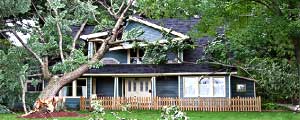Taking stock after a bad storm can be  overwhelming for a homeowner. Heavy rains, strong winds, and other storm conditions can cause great deals of damage in a short amount of time, with long-term repercussions. The good news is that quick action can mitigate losses. Here are some common types of storm damage, along with some tips on what you can do to kickstart the repair process.
overwhelming for a homeowner. Heavy rains, strong winds, and other storm conditions can cause great deals of damage in a short amount of time, with long-term repercussions. The good news is that quick action can mitigate losses. Here are some common types of storm damage, along with some tips on what you can do to kickstart the repair process.
Common Types of Storm Damage
Wind Storm Damage
Once they reach 50-60 mph, storm winds are labeled “damaging,” and can result in direct or indirect damage to homes, including direct damage includes torn shingles, detached gutters, and blown-off shutters.
Indirect wind damage occurs when winds send foreign objects crashing into homes. Downed limbs and flying debris can take out doors and windows, or further destroy roofs.
Downed Trees and Utility Poles Storm Damage
Downed trees and utility poles can cause severe storm damage to homes. Weakly-rooted trees are the most likely to topple and can puncture roofs and bring down entire sections of a home.
Utility poles can also fall in storms, often instigated by downed trees. In addition to possible impact damage, damaged wires can cause blackouts and/or fires. If you see a utility wire down, do not approach or touch it. It is likely to stay live until your utility company comes and disconnects it. Call your utility company and let them know.
Water Storm Damage
Deluges of water during storms can seep into homes causing widescale damage on every level through roof leaks, foundation cracks, and damaged drains or gutters. Water leaks in these areas typically lead to damage in ceilings, walls, flooring, and basements. Internal wiring can be destroyed by the inundation of water during a storm. Large quantities of water can also cause ponding outside and flooding indoors.
If not taken care of quickly, water damage can lead to mold, and can further weaken affected spaces. Mold thrives in moist environments and can destroy furniture, carpets, walls, and other items, and can jeopardize air quality.
Lightning Storm Damage
While lightning is known to hit higher buildings and targets, houses can be hit. When that happens, electrical devices and wiring are likely to sustain storm damage from electrical surges. On occasion, fires can occur.
Hail Storm Damage
Many storms can bring a mix of conditions. Heavy rains can come with hail, and even the smallest pea-sized balls can gather enough momentum as they fall, and can cause damage. Generally, hail damage affects roofs, exterior lighting, windows, and skylights, usually by shattering roof tiles and glass.
Related: Protect Your Home From Storm Damage
Immediate Steps to Take After Storm Damage
Once conditions are safe, take steps to prevent further storm damage and to get the repair process started.
- Take stock: Check your house for leaks, cracks, or any other damage mentioned above.
- Vacate or cordon off any areas that present an immediate danger, such as exposed wiring or saturated walls or ceilings in danger of collapse.
- If you’ve been flooded, begin draining or pumping water out of the affected areas of your house as soon as you can. Install a dehumidifier to remove any remaining moisture.
- Remove any downed branches or debris from your property.
- Seal off broken windows and skylights.
- Call your insurance company immediately.
- Call qualified repair companies for quotes as soon as possible, especially if a wide area has been affected.
Contact Först Consulting Group
If you need a roof inspection or want an advocate when negotiating with a contractor, contact us at Först Consulting Group. You don’t need to worry about being taken advantage of following storm damage with Först by your side. We can help negotiate a contract and inspect repairs to ensure they are done quickly and done right. Contact us today.




